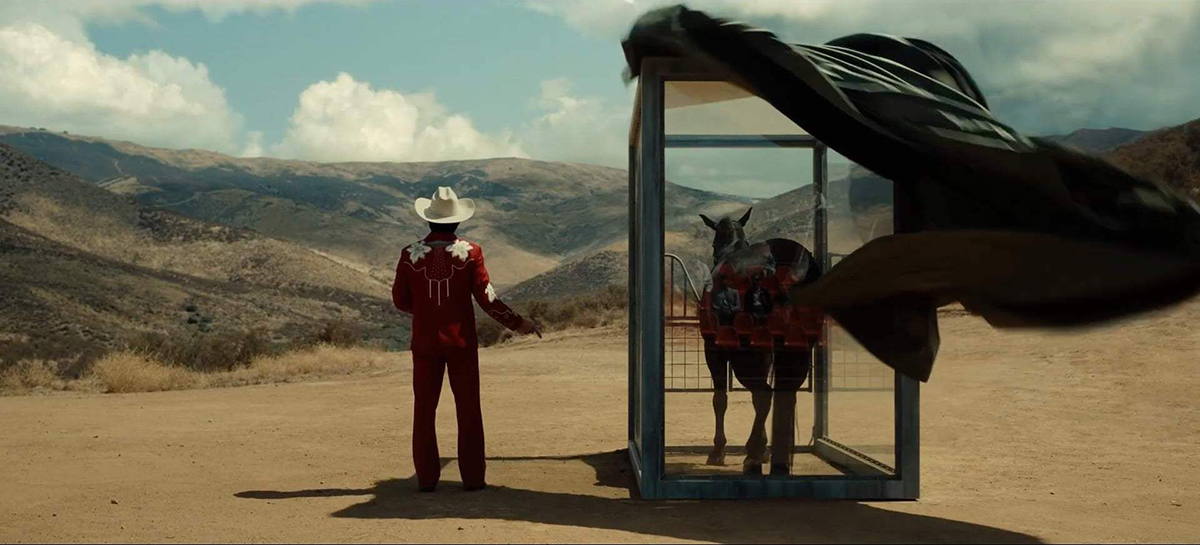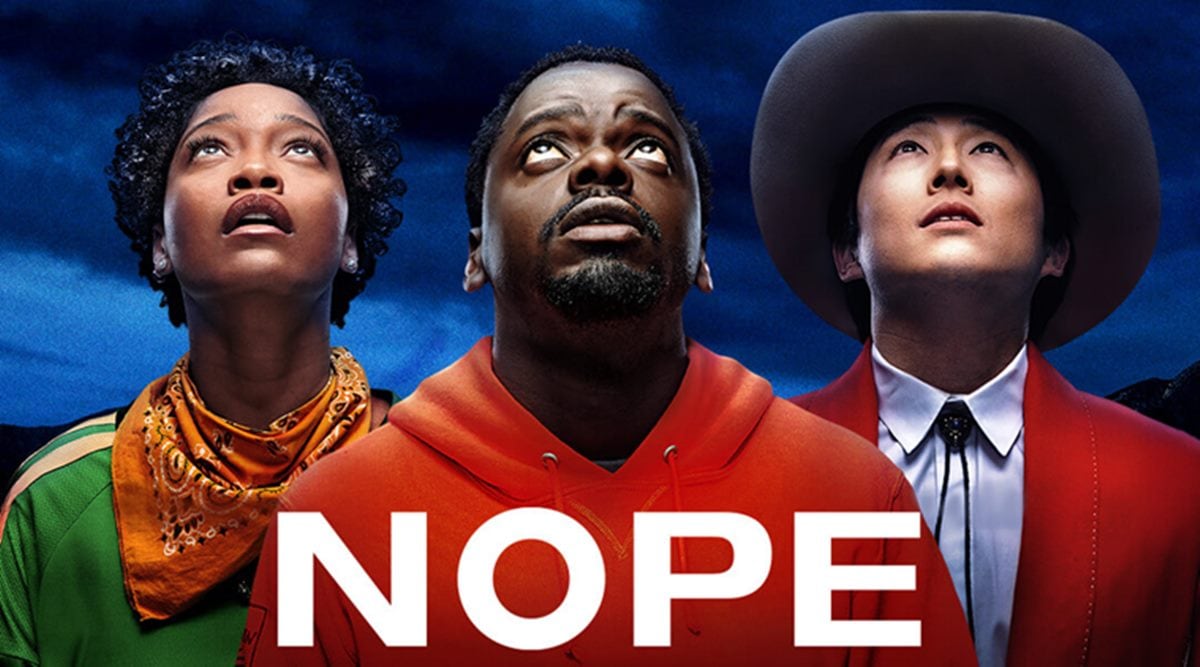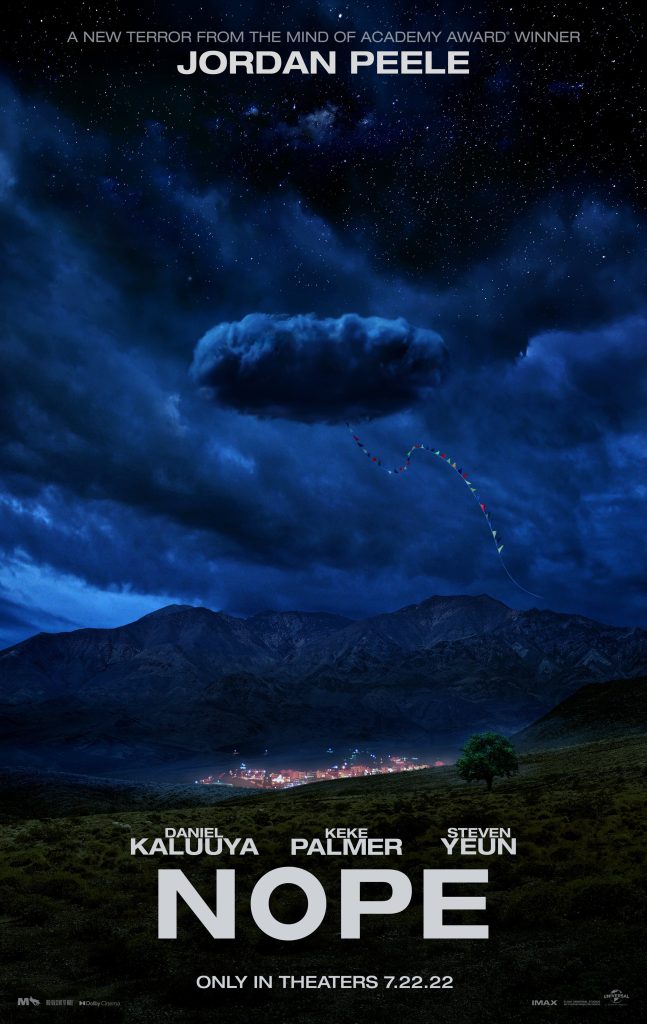Meta Description:
Read our detailed review of Nope (2022), Jordan Peele’s sci-fi horror film that blends spectacle with social commentary. Discover the themes, cinematography, and performances that make it a standout in modern genre cinema.

Jordan Peele’s Nope (2022) is a visually stunning and thematically complex film that blends sci-fi, horror, and social commentary. Known for his ability to create thought-provoking films that delve into societal issues, Peele has once again delivered a unique genre piece that combines the tension of alien encounters with deeper explorations of race, exploitation, and the commodification of spectacle. The film follows siblings OJ (Daniel Kaluuya) and Emerald Haywood (Keke Palmer), who, as horse wranglers in California, set out to capture footage of a mysterious UFO. What follows is a narrative that is both a gripping horror film and an intelligent commentary on the human fascination with danger.
The film’s visuals and cinematography, particularly in IMAX, create a spectacle that heightens the suspense and draws the audience into its eerie atmosphere. But Nope is more than just a surface-level horror flick; it explores themes of trauma, societal desensitization, and the darker side of human curiosity. Let’s take a deep dive into the key elements that make Nope a standout film of 2022.
H2: The Visual and Cinematic Spectacle
One of the standout features of Nope is its cinematography. The visual elements of the film are meticulously crafted, from the vast, open desert landscapes to the dark, suspenseful moments of UFO encounters. Cinematographer Hoyte van Hoytema (known for his work on Dunkirk and Interstellar) masterfully captures the tension of each scene, using lighting and framing to elevate the horror and spectacle.
H3: Hoyte van Hoytema’s Cinematography
The work of Hoytema is particularly impressive, especially given how important the visuals are to the film’s impact. From the wide shots of the expansive desert to the haunting, intimate moments during UFO encounters, every frame feels purposeful. The sweeping cinematography immerses the audience into the environment, while close-up shots during critical moments amplify the characters’ emotions. These visual choices ensure that Nope is as much a visual experience as it is a narrative one, drawing viewers into its world with every frame.
Watching Nope in IMAX takes the experience to the next level. The larger-than-life visuals, paired with the vastness of the California desert, create a sense of isolation and danger. Every encounter with the UFO feels more visceral, and the impact of the horror elements is amplified by the towering screen and immersive sound design.

H2: Themes and Ambition
Peele’s films are known for their social commentary, and Nope is no exception. While it presents itself as a UFO horror movie, the film subtly weaves in complex themes related to race, trauma, and the commodification of danger. Through the lens of the UFO encounter, Peele examines how society consumes spectacle and the consequences of being desensitized to violence and trauma.
H3: Social Commentary and Race
At its core, Nope is a meditation on race and exploitation. The characters of OJ and Emerald, both African American horse wranglers, find themselves caught in a system that commodifies their work and their labor. The UFO, a symbol of predatory consumption, serves as a metaphor for how marginalized communities are often exploited for entertainment and spectacle.
In the film, OJ and Emerald are part of the entertainment industry, which has historically disregarded people of color. The UFO represents a new kind of predatory force, one that seeks to consume and exploit them in ways they cannot control. Peele’s subtle commentary on capitalism, spectacle, and race is layered into the narrative, making it a thought-provoking film that speaks to modern societal issues.
H3: The Metaphorical Throughline
Nope does not hold the viewer’s hand when it comes to its symbolism. The film’s complex metaphorical landscape invites viewers to interpret the meaning of the UFO and its relationship to human consumption. The UFO is not just an alien threat but a symbol of our constant desire for spectacle, no matter the cost. Peele doesn’t provide all the answers, which allows for a deeper level of engagement from the audience, as they piece together the metaphors for themselves.
This ambiguity adds depth to the film but may leave some viewers frustrated, as they may expect a clearer explanation of the UFO’s origins and motivations. However, this open-ended nature invites multiple interpretations and encourages deeper analysis, which is one of the hallmarks of Peele’s filmmaking.
H2: Originality and Creativity
Unlike traditional alien invasion films, Nope offers a fresh and inventive take on the genre. Peele reimagines the UFO as a predatory force, challenging viewers to reconsider their assumptions about extraterrestrial life. The film blends traditional horror elements with innovative storytelling, making it both a thrilling and intellectually stimulating experience.
H3: A Fresh Take on UFOs and Horror
Nope is a standout in the alien genre because it doesn’t rely on the typical tropes. Rather than focusing on extraterrestrial beings with unknown intentions, Peele crafts a UFO that behaves more like a predator, stalking its prey and using fear as its weapon. This predatory UFO is not the standard image of an alien spaceship but something that actively seeks to consume and destroy.
The horror in Nope is not just about fear of the unknown; it is about fear of exploitation and consumption. The characters must deal with the very real threat of being consumed by something they don’t fully understand, making the film more than just a sci-fi horror—it becomes a social commentary wrapped in a thrilling package.

H3: Gordy’s Rampage and Meta-Commentary
One of the most memorable scenes in Nope involves Gordy, an ape who has a violent rampage, which ties into the film’s larger themes of spectacle and trauma. This unexpected subplot offers a meta-commentary on the film industry and how violence and danger are often sensationalized for public consumption. Gordy’s actions serve as a metaphor for the broader themes of exploitation that run throughout the film, making his story a critical part of the narrative.
Gordy’s rampage is an unnerving moment that contrasts sharply with the UFO story, highlighting the way society consumes both human and animal suffering as entertainment. This subplot adds an additional layer of horror and critique, reinforcing the film’s commentary on desensitization to violence.
Stay tuned for the second half of this review, where we will delve into the performances of Keke Palmer and Daniel Kaluuya, pacing issues, and the overall impact of Nope.
For more on Jordan Peele’s filmmaking and social commentary in horror, check out our Peele Filmography Review and Top Sci-Fi Horror Movies.
H2: Performances that Anchor the Film
The performances in Nope elevate it from a conventional sci-fi horror to a deeply engaging and emotionally resonant experience. Both Keke Palmer and Daniel Kaluuya deliver standout performances, bringing their characters to life in ways that keep audiences hooked from start to finish. Their dynamic chemistry is essential to the emotional weight of the story.
H3: Keke Palmer’s Dynamic Performance
Keke Palmer shines as Emerald Haywood, OJ’s sister, who is determined to capture the UFO on camera. Palmer brings a bold energy to her role, offering both humor and vulnerability as she grapples with the trauma of their family’s history and the challenges of dealing with a mysterious alien presence. Emerald’s ambition and strength are on full display in Palmer’s portrayal, making her a relatable character for audiences.
Emerald’s relationship with OJ is one of the film’s emotional cores, and Palmer’s performance helps ground the movie in real, human emotion. She offers a balance of resilience and hope, giving depth to the character’s role in the narrative and the film’s broader themes.

H3: Daniel Kaluuya’s Subdued Role
Daniel Kaluuya plays OJ Haywood, the quieter, more reserved brother who feels more connected to the land and his family’s legacy than to the spectacle surrounding the UFO. Kaluuya’s performance is subtle but impactful. His stoic nature and internal struggles make OJ a compelling and complex character. Kaluuya’s understated approach allows for a more grounded portrayal that contrasts well with the larger-than-life events unfolding in the film.
Kaluuya’s performance complements Palmer’s vibrant portrayal of Emerald, with the siblings’ differing approaches to their shared trauma and goals being a key element in the story’s emotional dynamics. Kaluuya’s quieter presence allows the narrative’s themes of fear, family, and exploitation to come through in an understated, yet powerful way.
H2: Weaknesses and Criticisms
While Nope is an ambitious and thought-provoking film, it is not without its flaws. Some critics have pointed out issues with pacing, ambiguity, and character development. While the film is largely successful in its storytelling, these minor criticisms have been noted by viewers who were hoping for a more cohesive and clear-cut narrative.
H3: Pacing and Focus Issues
One common criticism of Nope is its pacing, especially in the final act. While the film starts strong, with compelling character moments and mounting suspense, some viewers feel that the third act rushes through key developments. The urgency of the climax feels slightly undercut by a lack of clarity around the UFO’s origins and intentions.
The pacing, particularly towards the end, sometimes feels forced, as the film tries to tie up its themes and storylines. This rushed conclusion leaves certain questions unanswered, which, while fitting with Peele’s style of ambiguity, may leave some viewers unsatisfied.
H3: Ambiguity and Symbolism
As with much of Peele’s work, Nope thrives on ambiguity, but this can be a double-edged sword. The film’s rich symbolism, while compelling, may frustrate viewers who are looking for a more straightforward narrative. Peele leaves many of the film’s questions and themes open-ended, allowing the audience to interpret them in different ways.
This deliberate lack of explanation, especially regarding the UFO’s backstory and its connection to the human characters, may be seen as a missed opportunity to deepen the thematic exploration. While this is in line with Peele’s penchant for layered storytelling, it could alienate viewers who prefer more concrete resolutions in their films.
H2: Overall Verdict: A Thoughtful, Genre-Bending Experience
Despite its flaws, Nope is a bold and entertaining film that stands out in the sci-fi and horror genres. It blends spectacle with sharp social commentary and offers a unique approach to the UFO narrative. Peele’s ability to use genre filmmaking to address complex issues like race, trauma, and exploitation is one of the film’s strongest points.
H3: A Fitting Conclusion to Peele’s Legacy
Nope continues Jordan Peele’s streak of genre-defying films that use horror and science fiction to explore relevant societal issues. While it may not be as polished or universally loved as Get Out or Us, it remains a bold and creative addition to his filmography. The film’s willingness to ask questions without providing all the answers makes it a thought-provoking experience that resonates with audiences long after the credits roll.
The film’s originality, combined with its rich symbolism, makes it a standout film in the post-pandemic cinema landscape. Peele proves once again that he is a filmmaker who isn’t afraid to take risks, offering a film that demands attention and analysis.

In conclusion, Nope is a bold, brainy, and entertaining horror-sci-fi film that pushes the boundaries of the genre. It’s a must-watch for those who enjoy a thought-provoking narrative and enjoy films that mix intellectual depth with thrilling spectacle. Peele’s film isn’t just a horror movie—it’s a sharp critique of society’s relationship with spectacle and exploitation.
For more on Nope and its deeper themes, check out our Jordan Peele Filmography Review and explore Top Sci-Fi Horror Movies of 2022.

